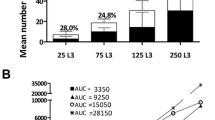Abstract
In rats infected with different worm burdens of Angiostrongylus cantonensis, the loss of body weight was proportional to the increasing dose of infection. Body weight was correlated inversely with female worm burden (r=−0.669), the sum of mean numbers of larvae per gram of faeces (LPG) (r=−0.527) and lung weight (r=−0.761). Lung weight was positively correlated with female worm burden (r=0.785) and the sum of mean numbers of LPG (r=0.685). On the other hand, in rats infected with larvae developed from gamma-irradiated first-stage larvae (Experiment B) or infected rats treated with the drug ivermectin (Experiment C), body weight was inversely correlated with the sum of mean numbers of LPG (r= −0.798, Experiment B; r=−0.670, Experiment C) and lung weigth (r=−0.862, Experiment B; r= −0.812, Experiment C), but not with female worm burden. Furthermore, lung weight was positively correlated with the sum of mean numbers of LPG (r=−0.783, Experiment B; r=0.899, Experiment C), but not with the female worm burden. From these results, it is concluded that in the later pulmonary phase of infection in rats the pathogenic effects may be closely related to the increasing number of first-stage larvae produced by female worms.
Similar content being viewed by others
References
Alicata JE (1962) Angiostrongylus cantonensis (Nematoda: Metastronglidae) as a causative agent of eosinophilic meningits of man in Hawaii and Tahiti. Can J Zool 40:5–8
Alicata JE, Jindrak K (1970) Murine angiostrongylosis. In: Anderson HH (ed) Angiostrongylosis in the Pacific and Southeast Asia. Thomas, Springfield, Ill, pp 50–62
Cuckler AC, Egerton JR, Alicata JE (1965) Therapeutic effect of thiabendazole on Angiostrongylus cantonensis infections in rats. J Parasitol 51:392–396
Hayashi M, Terada M, Ishii AI, Kino H, Sano M (1982) Studies on chemotherapy of parasitic helminths (XIV). Anthelmintic effect of mebendazole on Angiostrongylus cantonensis in rats. Jpn J Parasitol 31:575–580
Ishii AI, Terada M, Kino H, Hayashi M, Sano M (1983) Studies on chemotherapy of parasitic helminths: effects of avermectin B1a on Angiostrongylus cantonensis in rats. Int J Parasitol 13:491–498
Ishii AI, Terada M, Sano M (1985) Studies on chemotherapy of parasitic helminths (XX). Effects of ivermectin on Angiostrongylus cantonensis in rats. Jpn J Parasitol 34:411–417
Ishii AI, Honda M, Sano M (1987) Late development and fertility of adult worms derived from gamma-irradiated firststage larvae of Angiostrongylus cantonensis. Parasitol Res 73:159–164
Jindrak K (1968) Early migration and pathogenicity of Angiostrongylus cantonensis in laboratory rats. Ann Trop Med Parasitol 62:506–517
Jindrak K (1970) The pathology of intracranial angiostrongylosis in rats. J Comp Pathol 80:287–297
Jindrak K, Alicata JE (1969) Effect of l-tetramisole on Angiostrongylus cantonensis infection in rats. Chemotherapy 14:244–252
Kino H (1984) Parasite density and the fecundity of Angiostrongylus cantonensis in rats. Parasitology 89:275–285
LÄmmler G, Weidner E (1975) Zur larviziden Wirkung von Anthelminthika gegen Angiostrongylus cantonensis. Berl Münch TierÄrztl Wochenschr 88:152–156
Lim BL, Ow-Yang CK, Lie KJ (1965) Natural infection of Angiostrongylus cantonensis in Malayan rodents and intermediate hosts, and preliminary observations on acquired resistance. Am J Trop Med Hyg 14:610–617
Mackerras MJ, Sandars DF (1955) The life history of the rat lung-worm, Angiostrongylus cantonensis (Chen) (Nematoda: Metastrongylidae). Aust J Zool 3:1–21
Maki J, Yanagisawa T (1983) A comparison of the effects of flubendazole and thiabendazole on the larvae of Angiostrongylus cantonensis, Trichinella spiralis, Diphyllobothrium erinacei and Hymenolepis nana in mice. Parasitology 87:525–531
Nishimura K (1965/66) Experimental studies on the chemotherapy of rat lungworm, Angiostrongylus cantonensis, in rats. Chemotherapia 10:164–175
Nishimura K (1966) Angiostrongylus cantonensis infection in albino rats. Jpn J Parasitol 15:116–123 (English summary)
Ratnoff OD (1969) Some relationships among hemostasis, fibrinolytic phenomena, immunity and the inflammatory response. Adv Immunol 10:145–227
Sano M, Terada M, Ishii AI, Kino H, Hayashi M (1982) Studies on chemotherapy of parasitic helminths (16) Effects of ivermectin on Angiostrongylus cantonensis in rats. Jpn J Parasitol (Suppl) 31:48 (in Japanese)
Shoho C (1966) Observations on rats and rabbits infected with Angiostrongylus cantonensis (Chen). Br Vet J 122:251–258
Tiengkamol Y, Brockelman CR (1982) Angiostrongylus cantonensis: biogenic amines in the lungs of infected rats. Exp Parasitol 54:121–128
Weinstein PP, Rosen L, Laqueur GL, Sawyer TK (1963) Angiostrongylus cantonensis infection in rats and rhesus monkeys, and observations on the survival of the parasite in vitro. Am J Trop Med Hyg 12:358–377
Yong WK, Dobson C (1982) Population dynamics of Angiostrongylus cantonensis during primary infection in rats. Parasitology 85:399–409
Author information
Authors and Affiliations
Rights and permissions
About this article
Cite this article
Ishii, A.I. Pathogenic factors in the later pulmonary phase of Angiostrongylus cantonensis-infected rats. Parasitol Res 73, 458–465 (1987). https://doi.org/10.1007/BF00538205
Accepted:
Issue Date:
DOI: https://doi.org/10.1007/BF00538205




